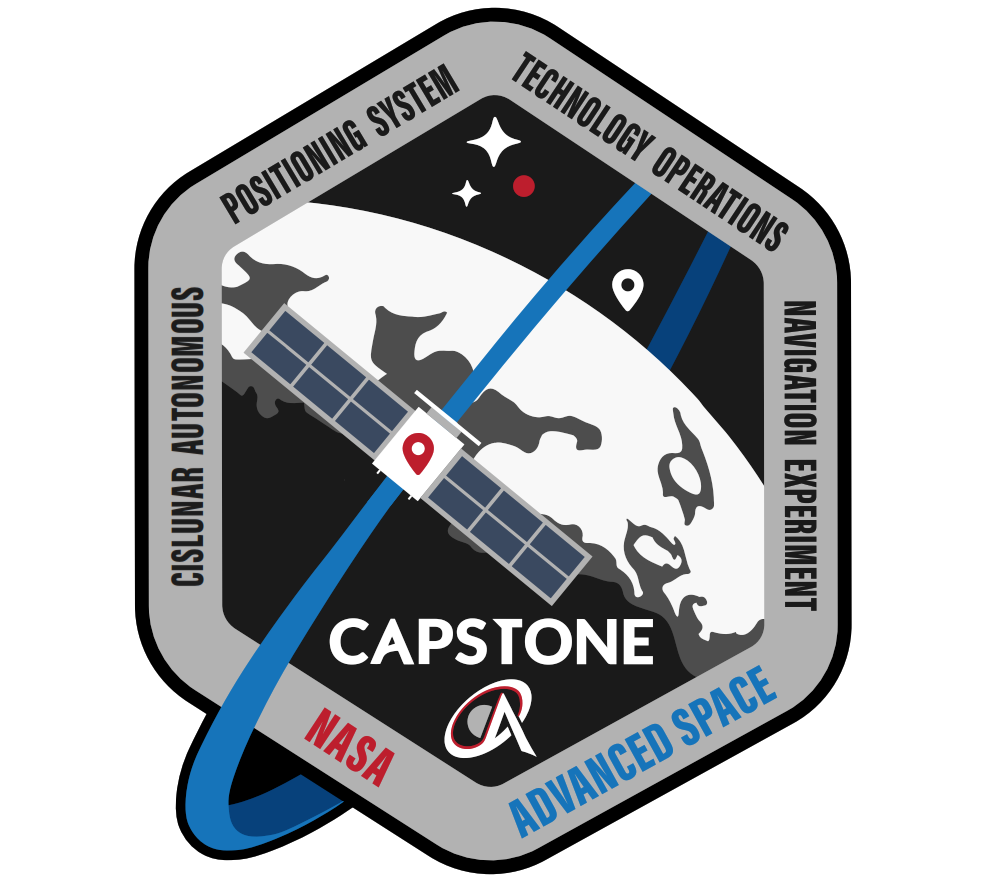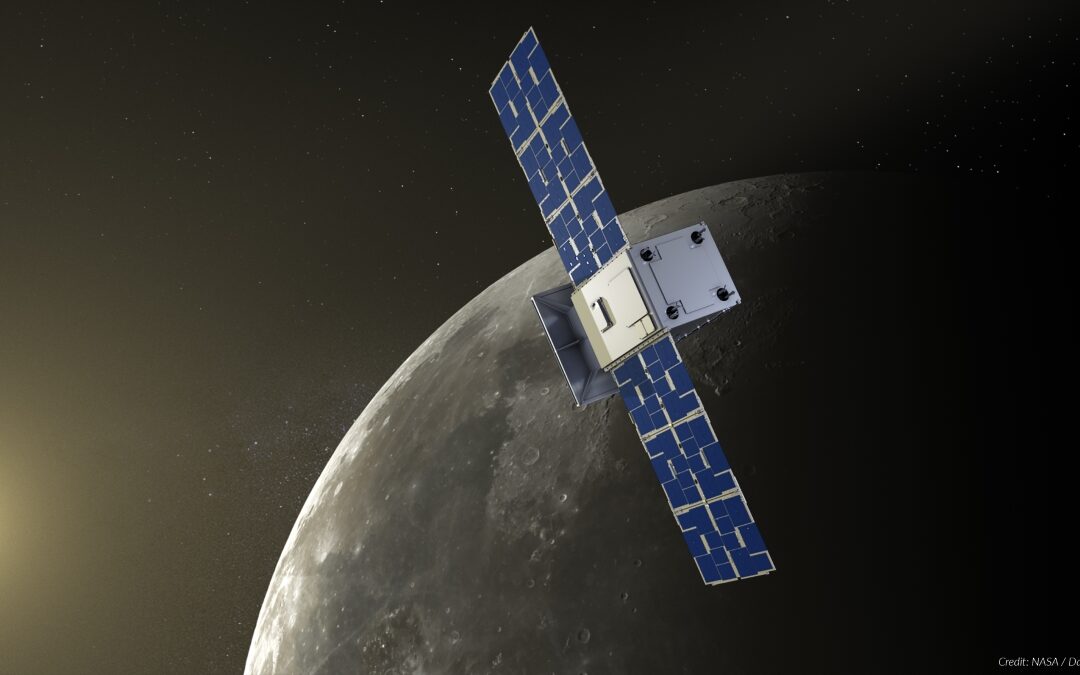It’s been one year since CAPSTONE separated from its launch vehicle to become the first commercial spacecraft operating at the Moon. Advanced Space is grateful to our team members and proud of all their accomplishments!
A Rocky Start
One year ago, we were sweating a bit. On July 4, after CAPSTONE separated from its launch vehicle, it had deployed its solar arrays; started charging its battery; pointed itself toward Earth; and communicated with Deep Space Network (DSN) stations in Madrid, Spain. The operations team had begun check-out and commissioning of the spacecraft. We were also able to determine spacecraft state (position and velocity) and to design our initial trajectory correction maneuver (TCM).
Then it went silent.
This is not the sort of thing you want to happen on your way to the Moon.
Obviously, we had to adjust our operations until we reestablished contact. We put off that first TCM, which was possible because our more leisurely ballistic lunar transfer (BLT) allowed for minor changes. Meanwhile, as our microwave-sized spacecraft passed 285,000 kilometers from Earth, we brought “all hands on deck” to work the communication problem. Two days later, through that combined team effort, we determined what caused the problem and how to fix it.
Ethan Kayser, who was the mission design lead on CAPSTONE, recalls:
“When we lost contact with CAPSTONE shortly after initial acquisition my heart sank. I knew the mission wasn’t necessarily over, our success during initial acquisition and commissioning gave me hope that the spacecraft was recoverable, but losing contact this early into the mission meant any number of things could be wrong. To deal with the stress, the team and I focused on solving the problem. I worked with the navigation team to assess our best estimate of where the spacecraft was, ensuring that we were giving the DSN the best direction to point to listen for and talk with CAPSTONE. We compared state estimates from separation, orbit determination solutions, and initial acquisition and they all corroborated that the DSN was pointing at our spacecraft, it just wasn’t talking back. When we finally did hear from CAPSTONE, I texted my wife, “Our spacecraft is alive and talking to us again!!!!!”, personifying this hunk of metal that we had spent three years planning to get to space. Prior to launch CAPSTONE mostly existed to me as 1’s and 0’s in my mission simulations, now it was alive and on its way to the Moon.”
While out of communication with Earth, CAPSTONE had continued charging its battery, remained properly pointed toward Earth, and performed an autonomous momentum desaturation maneuver. It was, to use a phrase that drives our engineers crazy, happy and healthy.
Thruster Problems
Unfortunately, another anomaly arose two months later.
During or shortly after the third TCM on September 8, the spacecraft suffered an anomaly that caused the vehicle’s attitude to change to beyond the capacity of the onboard reaction wheels to control and counter. The vehicle attempted to communicate with the ground for approximately 24 hours before we recovered any telemetry. When we regained contact, the spacecraft was not in a 3-axis stabilized configuration, it was losing power, and was experiencing periodic system resets. Navigation data collected after the anomaly suggested that TCM-3 was completed or nearly complete when the anomaly occurred. This meant that the spacecraft remained on the intended trajectory and on course to its near-rectilinear halo orbit (NRHO) at the Moon but was now spinning at a high rate.
Working with limited data, the combined operations team declared an operational emergency on September 8. Once again, teams at the DSN, Jet Propulsion Laboratory, Space Dynamics Laboratory, Terran Orbital, and Advanced Space began an around-the-clock work session to address the problem, understand what was happening, and identify options to recover.
The mission operations team worked to improve the thermal situation of several subsystems, including propulsion; diagnosing the cause of the anomaly; and detumbling CAPSTONE to regain attitude control. This detumble operation allowed the vehicle to resume control of its orientation, turning the solar panels to the Sun to fully charge the batteries. The spacecraft then oriented back to the ground to await further instructions.
Over the following week, the CAPSTONE spacecraft experienced improved thermal conditions while maintaining positive power generation. The operations team performed ground and spacecraft testing to attempt to stop CAPSTONE’s spin. The spacecraft returned to normal.
Moving into October, our mission team and key partners identified the most likely cause of the anomaly as a valve on one of the spacecraft’s eight (8) thrusters. The partially open valve resulted in the thruster firing whenever the propulsion system pressurized. To recover from this condition, the mission team uploaded a recovery sequence to the spacecraft on October 6 and executed it October 7. The new programming resulted in successful recovery of 3-axis attitude control, enabling us to orient the spacecraft solar arrays toward the Sun and to orient the downlink antennas to significantly improve data downlink performance. This was a major accomplishment for the mission team and positioned CAPSTONE for its arrival at the Moon on November 13.
Achievements Since Last Year
Despite all the early excitement, what has pleased us most about CAPSTONE are the accomplishments it has achieved during its primary mission: testing the Cislunar Autonomous Positioning System (CAPS). This has been done through a combination of ground-based measurements of its orbit by the DSN, especially the 21-meter dish at Morehead State University in Kentucky, along with communications with Earth and the Lunar Reconnaissance Orbiter (LRO). By successfully sending a signal to LRO and receiving it back, CAPSTONE processed the measurements computed from the signal to determine the absolute position and velocity of both spacecraft. This sort of shared information can serve a purpose like the Global Positioning System for spacecraft and surface vehicles at the Moon. The more additions to the system, the more accurate it will become, with less reliance on ground systems from Earth.
As part of CAPSTONE’s technology demonstrations, the spacecraft is equipped with a Chip Scale Atomic Clock (CSAC) to demonstrate one-way, uplink navigation. The precise timing of the CSAC is used in conjunction with an uplink signal on the ground to compute range and Doppler measurements on the spacecraft as part of our CAPS navigation technology to estimate the spacecraft’s state. In the last few weeks, the team has been working to demonstrate this capability and successfully executed the onboard testing required to demonstrate the one-way navigation technology. In the coming weeks, the team will execute this first one-way demonstration in full.
In the year since its separation, CAPSTONE has completed 18 maneuvers, 35 successful orbits (as of July 1st), and 365,726 total Deep Space Network measurements from 420 tracking passes. including the site at Morehead State University.
CAPSTONE also has earned Advanced Space numerous awards and achieved several “firsts.” It became the first commercial spacecraft operating at the Moon; the first CubeSat to use a ballistic lunar transfer to Moon, traveling over 1.5 million kilometers from Earth; the first spacecraft to enter and operate in a near-rectilinear halo orbit (NRHO), the same orbit that will be used by the Gateway space station; and the first to demonstrate an innovative spacecraft-to-spacecraft navigation technology: the CAPS. This past June, Advanced Space received a Group Achievement Award from NASA for its work on CAPSTONE.
Looking back on all these accomplishments, Advanced Space CEO and CAPSTONE Principal Investigator Bradley Cheetham said, “I couldn’t be prouder of our engineers, our team members, and our spacecraft. They’ve performed heroic work to bring us to where we are today, which is a highly accomplished spacecraft helping lead the way back to the Moon.”
About CAPSTONE™: CAPSTONE Press Kit
CAPSTONE™ is owned and operated by Advanced Space. It is one of the first CubeSats to fly in cislunar space – the orbital area near and around the Moon – and demonstrate an innovative spacecraft-to-spacecraft navigation technology. The mission launched on June 28, 2022. Critical partners in the CAPSTONE mission include:

-
- NASA: CAPSTONE’s development is supported by the Space Technology Mission Directorate via the Small Spacecraft Technology and Small Business Innovation Research programs at NASA’s Ames Research Center in California’s Silicon Valley. The Artemis Campaign Development Division within NASA’s Exploration Systems Development Mission Directorate supported the launch and mission operations. NASA’s Launch Services Program at Kennedy Space Center in Florida was responsible for launch management. NASA’s Jet Propulsion Laboratory supported the communication, tracking, and telemetry downlink via NASA’s Deep Space Network, Iris radio design and groundbreaking 1-way navigation algorithms.
- Terran Orbital Corporation: Spacecraft design, development and implementation, hardware manufacturing, assembly, testing and mission operations support.
- Stellar Exploration: Propulsion subsystem provider.
- Rocket Lab USA, Inc.: Launch provider for CAPSTONE on a three-stage Electron launch vehicle.
- Space Dynamics Lab (SDL): Iris radio and navigation firmware provider.
- Orion Space Solutions (formerly Astra): Chip Scale Atomic Clock (CSAC) hardware provider necessary for the 1-way ranging experiment.
- Tethers Unlimited, Inc.: Cross Link radio provider.
- Morehead State University (MSU): Operates the newest “affiliated node” on the NASA Deep Space Network (DSN). Providing telemetry, tracking and control services for NASA and commercial space missions and to engage university students in deep space mission operations.
